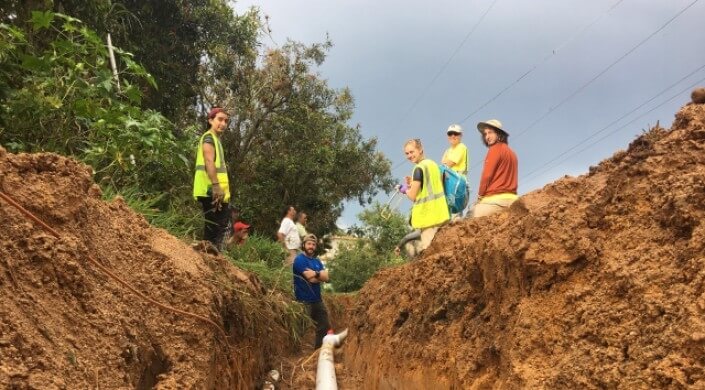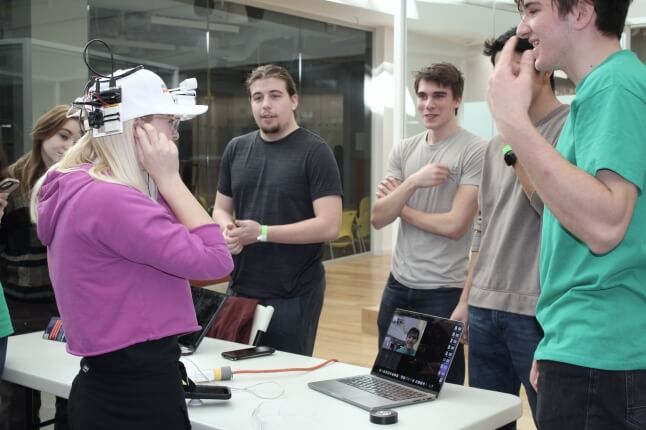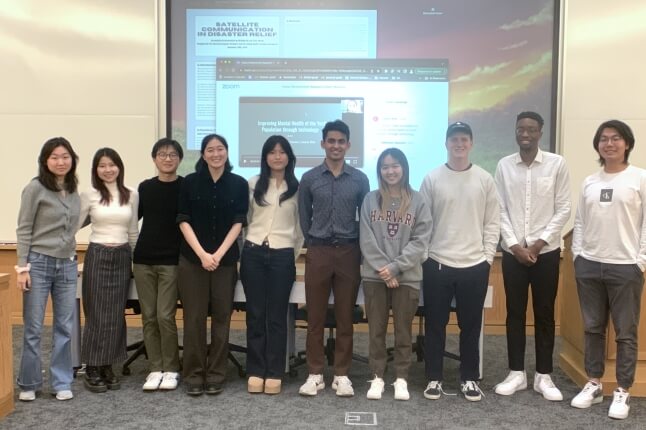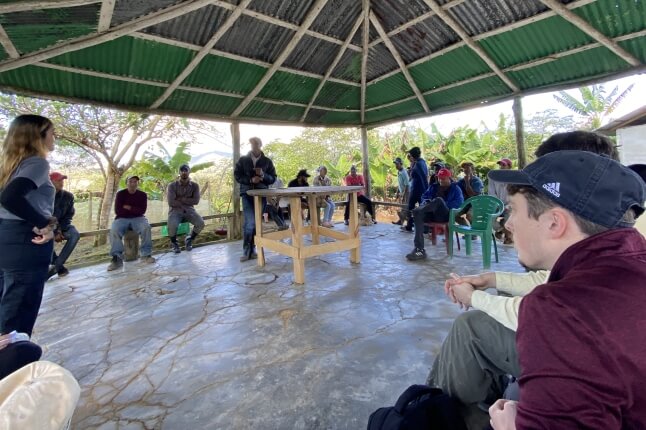News
Members of the Harvard Engineers Without Borders USA team in Los Sanchez, Dominican Republic, discuss the location of a valve box that was installed by the well. (Photo provided by McKenna Roberts.)
After hours of picking away at densely packed clay soil, the tools in their hands felt heavy as lead, but with pickaxes and shovels the Harvard students continued digging into the earth.
The undergraduates laying pipe for a water supply system in the Dominican Republic may have felt more comfortable in a classroom, solving a problem set using MATLAB. But Engineers Without Borders USA (EWB) projects require a more hands-on approach to problem solving.
“Harvard doesn’t train you to do construction work. For students here, it’s definitely not as common as consulting,” said EWB project lead McKenna Roberts, S.B. ’19, a bioengineering concentrator. “But these were the most educational weeks of my life.”
Roberts, along with Tomoya Hasegawa, A.B. ’18, a computer science concentrator, led an 11-person EWB team on a three-week trip to install a gravity-fed system in the village of Los Sanchez, Dominican Republic.
The project replaced a leaky and fragmented pipe network that often left villagers without water for extended periods. The gravity-fed design was essential to ensure the village, which lacks electricity for 12 hours each day, would have 24/7 access to water, Roberts said.
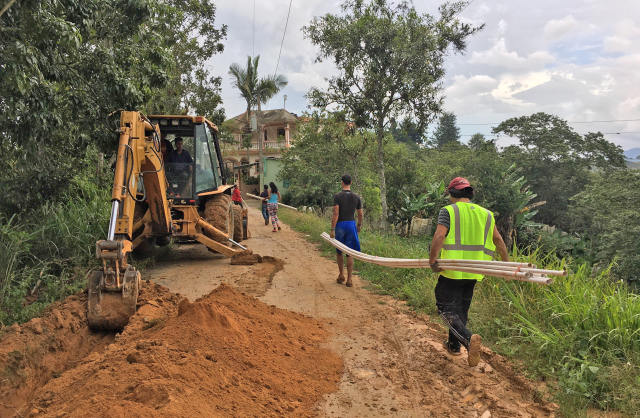
EWB team members bring pipes from their storage site to the excavation site. (Photo provided by McKenna Roberts.)
After spending the academic year designing a new water distribution system that would initially serve about a third of the village, the team arrived in the Dominican Republic eager to work. But they quickly ran into challenges. The official at the Ministry of the Environment was out of the office when they arrived, which stalled the team’s construction permit, and a balky excavator machine caused unexpected delays.
To overcome these challenges, the students and Los Sanchez community members often resorted to digging by hand, since using the excavator could have damaged existing pipes, lugged 90-pound bags of cement, and worked 10-hour days. But as they constructed valve boxes and laid 5,000 feet of pipe along the village’s main road, the project inched toward completion.
As they neared the end of the line, Roberts and her peers began to feel nervous. The topography of the village, which slopes down to the center and then back up, made it difficult to maintain adequate pressure at the end of the line. When the team designed the water distribution system, they carefully chose different pipe diameters at various points to ensure pressure remained in the desired range. But they weren’t able to test the end of the line before returning to Cambridge.
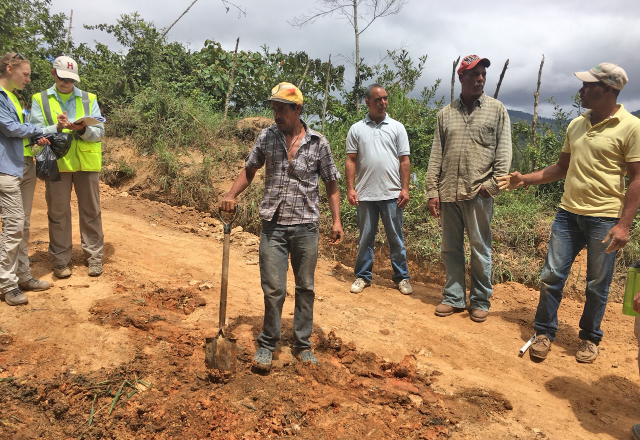
McKenna Roberts, S.B. ’19, a bioengineering concentrator and professional engineer Bree Carlson discuss where to install a tap stand with community members. (Photo provided by McKenna Roberts.)
Back at school, team members crowded around a computer screen to watch a video of the community members testing the end of the system; they cheered along with the villagers as a steady stream of water poured out.
“Our implementation taught me that not everything is as simple as planning out something to build and carrying it out, as there are many aspects of real-world application that simply cannot be replicated in a classroom,” said Sean Park, A.B. ’20, a computer science concentrator. “This project was not just an activity at school, but working together to achieve a goal that would affect hundreds of people's lives.”
The experience was exhausting and gratifying but the students are already looking to next summer’s phase of the project—building more valve boxes and laying additional pipe to connect the remainder of the village.
“Between the Los Sanchez project and a second EWB project in which a team designed and built a teachers’ residence in the remote Tanzanian village of Mkutani, students touched 2,500 lives this summer,” said Christopher Lombardo, EWB advisor and Associate Director for Undergraduate Studies in Electrical and Mechanical Engineering. “This isn’t a competition that you are going to win and put a trophy in a case. There are people in the Dominican Republic who have water every day now. Or in the case of Tanzania, hopefully there will be more teachers in Mkutani and more of those students will continue onto secondary school and make impacts on their families as a result.”
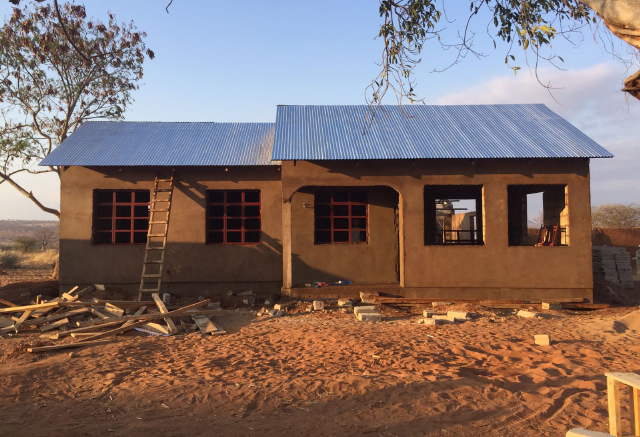
A second Harvard Engineers Without Borders USA team designed this teachers' residence for the remote village of Mkutani, Tanzania. Students traveled to Tanzania this summer to work with a local construction crew to build the residence. See sidebar article. (Photo provided by Nicole Trenchard.)
The Harvard SEAS Chapter of Engineers Without Borders USA (EWB-USA) offers students the opportunity to learn through service, building their interdisciplinary engineering skills and empowering them to create culturally conscious solutions while working directly with community partners. The Harvard projects are entirely student directed, with faculty mentor Chris Lombardo offering guidance, and professional mentors instructing students in disciplines (like civil engineering and hydraulics) that they do not have access to in the SEAS curriculum. Although the Harvard chapter is student run, Engineers Without Borders USA is a national organization that offers professional grade review and approval. This gives student groups the freedom to design solutions to community-driven projects while ensuring that their designs meet engineering standards.
Students design teachers’ residence for remote Tanzanian village
Mechanical engineering concentrator Robert Anderson, S.B. ’19, stared out into a pitch-black night that had settled over the Tanzanian village of Mkutani. Suddenly, a pair of blinding headlights cut through the darkness as an 18-wheeler carrying tons of bricks lumbered into town.
He, his fellow Harvard students and members of the community of Mkutani rushed outside to off-load the heavy bricks, which would be used to construct a new teacher’s residence that had been designed by the student-led Engineers Without Borders USA team. Anderson said he felt a wave of relief as the last brick was unloaded, since so much depended on this project’s successful completion.
Due to lacking running water and electricity, the primary school in Mkutani has struggled to attract and retain quality teachers, explained project co-lead Nicole Trenchard, S.B. ’19, a mechanical engineering concentrator. But if the village’s schoolchildren are unable pass the nation-wide grade seven exam, they cannot attend secondary school and lose any opportunity for higher education.
“We want the teachers to have a home so they can have the energy and dedication to overcome these hurdles and improve the education of the students,” Anderson said. “The first step in getting education to improve is getting really good teachers who are dedicated and willing to commit.”
With that goal in mind, five students and five practicing engineers spent four weeks in Mkutani, collaborating with a local construction crew to build a residence that can house up to three teachers and their families.
After a year of structural engineering mentorship and planning, the team travelled to Tanzania. But they quickly faced challenges when they arrived. Based on late feedback from the local school district, they made last-minute adjustments to their design to better suit cultural norms and community realities, such as walling in the outdoor kitchen, fire pit, and latrine.
Working with a local construction crew was a learning experience, Anderson said. The Harvard team walked the contractor through their structural calculations of load bearing beams and trusses, while learning local construction techniques and tricks from their partners. As the concrete brick structure rose from its foundation, the students also built relationships with community members.
Trenchard, project manager for the second half of the trip, learned the ins and outs of managing a construction site, but was especially thrilled to work directly with the community. She spoke with villagers about their hopes for the future while leading a women’s meeting.
“I still get chills from that,” she said. “For me, that community aspect was so much bigger than the structure we built. Sitting in those meetings, our impact was so tangible. It was no longer just engineering, it was helping people.”
The teacher’s residence complete, the students returned to Harvard already thinking about the next phase of the project. They are planning to spend the year designing a water catchment system for the village, since the nearest water source is a well 5 kilometers away.
Topics: Student Organizations
Cutting-edge science delivered direct to your inbox.
Join the Harvard SEAS mailing list.
Press Contact
Adam Zewe | 617-496-5878 | azewe@seas.harvard.edu
